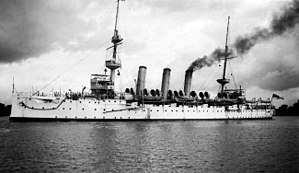
Back HMS Hermes (1898) Czech HMS Hermes (1898) German اچاماس هرمس (۱۸۹۸) Persian HMS Hermes (1898) Finnish HMS Hermes (1898) French HMS Hermes (1898) Italian
 HMS Hermes at anchor, Dar es Salaam, German East Africa, before 1913
| |
| History | |
|---|---|
| Name | HMS Hermes |
| Namesake | Hermes |
| Ordered | 1897 |
| Builder | Fairfield Shipbuilding & Engineering, Govan |
| Laid down | 30 April 1897 |
| Launched | 7 April 1898 |
| Christened | Lady Kelvin |
| Completed | 5 October 1899 |
| Reclassified | Fitted to carry seaplanes in 1913 |
| Fate | Sunk by U-27, 31 October 1914 |
| General characteristics (as built) | |
| Class and type | Highflyer-class protected cruiser |
| Displacement | 5,650 long tons (5,740 t) |
| Length | |
| Beam | 54 ft (16.5 m) |
| Draught | 21 ft 6 in (6.6 m) |
| Installed power |
|
| Propulsion |
|
| Speed | 20 kn (37 km/h; 23 mph) |
| Complement | 470 |
| Armament |
|
| Armour |
|
HMS Hermes was a Highflyer-class protected cruiser built for the Royal Navy in the 1890s. She spent much of her early career as flagship for various foreign stations before returning home in 1913 to be assigned to the reserve Third Fleet. The ship was modified later that year as the first experimental seaplane carrier in the Royal Navy. In that year's annual fleet manoeuvers, she was used to evaluate how aircraft could cooperate with the fleet and if aircraft could be operated successfully at sea for an extended time. The trials were a success and Hermes was paid off in December at their conclusion. She was recommissioned at the beginning of World War I in August 1914 for service as an aircraft ferry and depot ship for the Royal Naval Air Service. She was torpedoed and sunk by a German submarine in the Straits of Dover that October, with the loss of 21 lives.
Cite error: There are <ref group=Note> tags on this page, but the references will not show without a {{reflist|group=Note}} template (see the help page).
© MMXXIII Rich X Search. We shall prevail. All rights reserved. Rich X Search